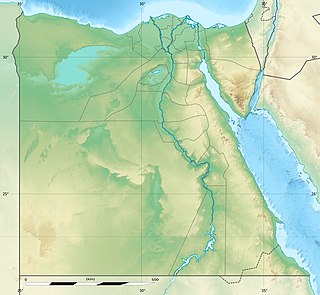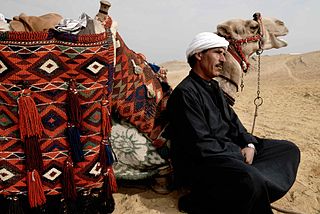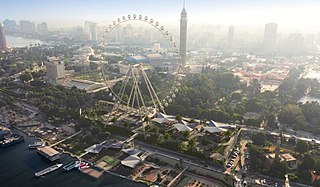
Egypt has a thriving cultural tourism industry, built on the country's complex history, multicultural population and importance as a regional centre.

Egypt has a thriving cultural tourism industry, built on the country's complex history, multicultural population and importance as a regional centre.

Egypt's cultural tourism trade has fluctuated since the 19th century, increasing in popularity alongside the rise of Egyptology as an academic and amateur pursuit. Successive Egyptian governments have placed great emphasis on the value of cultural tourism, "confident that no other countries could actually compete in this area". [1]


Tourists from South Asia and East Asia, in particular, have been identified as responding well to marketing campaigns that focus on Egyptian cultural tourism. Tourism Bureau representatives have announced plans to increase marketing spending on those regions. [2]
Signature Travel Network writer and Huffington Post columnist Jean Newman Glock notes that Egypt's cultural tourism trade is worth $10 to every $1 spent by tourists whose travel focuses on Egypt's Red Sea resorts. [3] As a result, she says, "Egypt is hoping those interested in exploring their antiquities will return, in great numbers, soon." [3]
According to the Huffington Post's Deborah Lehr; [4]
Before the Arab Spring, tourism accounted for approximately 11 percent of the country's GDP and was a significant job creator in the economy. In the aftermath of the 2011 Revolution, tourism dropped dramatically to 6.7 percent of GDP. Foreign travelers have stayed away during the political turmoil of the past three years. The breakdown in the security infrastructure also led to a massive increase in looting at archaeological sites -- a devastating loss of irreplaceable cultural material. In the months since General el-Sisi has taken power, Egypt has been slowly rebuilding its reputation as a safe destination for the world's adventurers.
According to industry representatives, the government, "recently [2014] announced a master plan to attract 25 million tourists by 2020". The plan includes dedicated online and traditional marketing strategies focused on assuring prospective tourists that cultural tourism centres are safe following the Arab Spring and Egyptian Revolution of 2011. [5]
In 2015, a conglomeration which includes the Egyptian Government signed an agreement with French company Prism to create a sound and light show encompassing the Giza Necropolis pyramids and the nearby Great Sphinx of Giza. The pyramids served as the site of the first African son et lumière in 1961. [6]

The economy of Jordan is classified as an emerging market economy. Jordan's GDP per capita rose by 351% in the 1970s, declined 30% in the 1980s, and rose 36% in the 1990s. After King Abdullah II's accession to the throne in 1999, liberal economic policies were introduced. Jordan's economy has been growing at an annual rate of 8% between 1999 and 2008. However, growth has slowed to 2% after the Arab Spring in 2011. Substantial increase of the population, coupled with slowed economic growth and rising public debt led to a worsening of poverty and unemployment in the country. As of 2019, Jordan boasts a GDP of US$44.4 billion, ranking it 89th worldwide.

A tourist attraction is a place of interest where tourists visit, typically for its inherent or an exhibited natural or cultural value, historical significance, natural or built beauty, offering leisure and amusement.

Giza is the second-largest city in Egypt after Cairo and fourth-largest city in Africa after Kinshasa, Lagos and Cairo. It is the capital of Giza Governorate with a total population of 8.8 million as of October 2018. It is located on the west bank of the Nile, 4.9 km (3 mi) southwest of central Cairo, and is a core city of the Greater Cairo metropolis. Giza lies less than 30 km (18.64 mi) north of Memphis (Men-nefer), which was the capital city of the first unified Egyptian state from the days of the first pharaoh, Narmer.

The Great Sphinx of Giza, commonly referred to as the Sphinx of Giza or just the Sphinx, is a limestone statue of a reclining sphinx, a mythical creature. Facing directly from west to east, it stands on the Giza Plateau on the west bank of the Nile in Giza, Egypt. The face of the Sphinx appears to represent the pharaoh Khafre.

The Egyptian pyramids are ancient masonry structures located in Egypt. Sources cite at least 118 identified Egyptian pyramids. Most were built as tombs for the country's pharaohs and their consorts during the Old and Middle Kingdom periods.

The Giza Pyramid Complex, also called the Giza Necropolis, is the site on the Giza Plateau in Greater Cairo, Egypt that includes the Great Pyramid of Giza, the Pyramid of Khafre, and the Pyramid of Menkaure, along with their associated pyramid complexes and the Great Sphinx of Giza. All were built during the Fourth Dynasty of the Old Kingdom of Ancient Egypt. The site also includes several cemeteries and the remains of a workers village.

Tourism is an economic contributor to the Kingdom of Thailand. Estimates of tourism revenue directly contributing to the GDP of 12 trillion baht range from one trillion baht (2013) 2.53 trillion baht (2016), the equivalent of 9% to 17.7% of GDP. When including indirect travel and tourism receipts, the 2014 total is estimated to be the equivalent of 19.3% of Thailand's GDP. The actual contribution of tourism to GDP is lower than these percentages because GDP is measured in value added not revenue. The valued added of the Thailand's tourism industry is not known. According to the secretary-general of the Office of the National Economic and Social Development Council in 2019, the government projects that the tourism sector will account for 30% of GDP by 2030, up from 20% in 2019.

The economy of Tibet is dominated by subsistence agriculture. Due to limited arable land, livestock raising is the primary occupation mainly on the Tibetan Plateau, among them are sheep, cattle, goats, camels, yaks, donkeys and horses. The main crops grown are barley, wheat, buckwheat, rye, potatoes, oats, rapeseeds, cotton and assorted fruits and vegetables. In recent years the economy has begun evolving into a multiple structure with agriculture and tertiary industry developing side by side.

Tourism in Vietnam is a component of the modern Vietnamese economy. In 2019, Vietnam received 18 million international arrivals, up from 2.1 million in the year 2000. The Vietnam National Administration of Tourism is following a long-term plan to diversify the tourism industry, which brings foreign exchange into the country.
Crime in Egypt is moderate, but still occurs in various forms. Forms of crime include drug trafficking, money laundering, fraud, corruption, black marketeering etc.

Tourism in Libya is an industry heavily hit by the Libyan Civil War. Before the war tourism was developing, with 149,000 tourists visiting Libya in 2004, rising to 180,000 in 2007, although this still only contributed less than 1% of the country's GDP. There were 1,000,000 day visitors in the same year. The country is best known for its ancient Greek and Roman ruins and Sahara desert landscapes.

Tourism is one of the leading sources of income, crucial to Egypt's economy. At its peak in 2010, the sector employed about 12% of workforce of Egypt, serving approximately 14.7 million visitors to Egypt, and providing revenues of nearly $12.5 billion as well as contributing more than 11% of GDP and 14.4% of foreign currency revenues.

Egypt's environmental problems include, but are not limited to, water scarcity, air pollution, damage to historic monuments, animal welfare issues and deficiencies in its waste management system.
Tourism in Sudan is a minor contributor to the country's economy. As of 2019, travel and tourism contributed about 2.4% of Sudan’s gross domestic product (GDP). Sudan is infrequently visited compared to other African countries, and long-running internal conflict has damaged the country's tourism industry.
Tourism brings both positive and negative impacts on tourist destinations. The traditionally-described domains of tourism impacts are economic, socio-cultural, and environmental dimensions. The economic effects of tourism include improved tax revenue and personal income, increased standards of living, and more employment opportunities. Sociocultural impacts are associated with interactions between people with differing cultural backgrounds, attitudes and behaviors, and relationships to material goods. Environmental impacts affect the carrying capacity of the area, vegetation, air quality, bodies of water, the water table, wildlife, and natural phenomena.

Terrorism and tourism in Egypt is when terrorist attacks are specifically aimed at Egypt's tourists. These attacks often end in fatalities and injuries and has an immediate and sometimes lasting effect on the industry. Attacks take many forms; blowing up an airplane carrying tourists, drive-by shootings of tourists, knife attacks on tourists and suicide explosions in a location where tourists are congregated. On the timeline of these events, the 1997 Luxor Massacre stands out - 62 tourists were ambushed and killed.

Rania A. Al-Mashat is an Egyptian economist and politician who was the country's Minister of Tourism from 2018 until December 2019. She previously held high level positions at the International Monetary Fund in Washington DC and at the Central Bank of Egypt. She is currently the Minister of International Cooperation as of December 2019.

Tourism in the United Arab Emirates is an important component of the Emirati economy, and consists of domestic and international components. In 2018, tourist industry composed over 164.7 billion dirham to country's GDP.

Cairo Eye, also known as Ain Cairo is a ferris wheel under construction located on the banks of the Nile River in the Zamalek district of Cairo, Egypt.